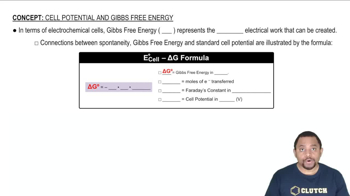The following cell reactions occur spontaneously: (b) Which of these substances (A,A+,B,B+,C,C+) is the strongest oxidizing agent? Which is the strongest reducing agent?
Use the data in Appendix D to predict whether the following reactions can occur under standard-state conditions. (c) Oxidation of Ag(s) by Pb2+(aq)

Verified Solution
Key Concepts
Standard-State Conditions

Oxidation-Reduction Reactions

Electrode Potentials and Gibbs Free Energy

Use the data in Appendix D to predict whether the following reactions can occur under standard-state conditions. (a) Oxidation of Sn2+(aq) by Br2(aq)
Use the data in Appendix D to predict whether the following reactions can occur under standard-state conditions. (b) Reduction of Ni2+(aq) by Sn2+(aq)
Use the data in Appendix D to predict whether the following reactions can occur under standard-state conditions. (d) Reduction of I2(s) by H2SO3(aq)
What reaction can occur, if any, when the following experiments are carried out under standard-state conditions? (a) Oxygen gas is bubbled through an acidic solution of Cr(NO3)3.
What reaction can occur, if any, when the following experiments are carried out under standard-state conditions? (b) A strip of lead is dipped into an aqueous solution of AgNO3.
